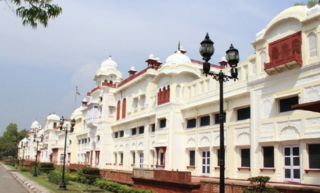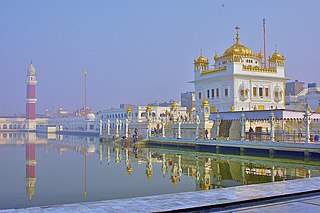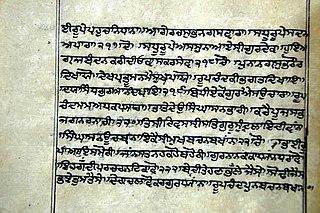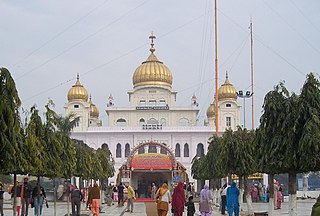| Dukh Nivaran Sahib | |
|---|---|
 Dukh Nivaran Sahib | |
 | |
| General information | |
| Architectural style | Sikh architecture |
| Town or city | Patiala |
| Country | India |
Gurdwara Dukh Nivaran Sahib is situated in what used to be the village of Lehal, now part of Patiala city.
| Dukh Nivaran Sahib | |
|---|---|
 Dukh Nivaran Sahib | |
 | |
| General information | |
| Architectural style | Sikh architecture |
| Town or city | Patiala |
| Country | India |
Gurdwara Dukh Nivaran Sahib is situated in what used to be the village of Lehal, now part of Patiala city.

According to local tradition, supported by an old handwritten document preserved in the Gurudwara, one Bhag Ram, a jhivar of Lehal, waited upon ninth guru of Sikhs Guru Tegh Bahadur during his sojourn at Saifabad (now Bahadurgarh), and made the request that he might be pleased to visit and bless his village so that its inhabitants could be rid of a serious and mysterious sickness which had been their bane for a long time.
The Guru visited Lehal on Magh sudi 5, 1728 Bikram/24 January 1672 and stayed under a banyan tree by the side of a pond. [1] The sickness in the village subsided. The site where Guru Tegh Bahadur had sat came to be known as Dukh Nivaran, literally meaning eradicator of suffering. Devotees have faith in the healing qualities of water in the sarovar attached to the shrine.
Raja Amar Singh of Patiala (1748–82) had a garden laid out on the site as a memorial which he entrusted to Nihang Sikhs. Records of a court case in 1870 mention a Guru's garden and a Nihangs' well being in existence here. In 1920, during a survey for the proposed construction of Sirhind-Patiala-Jakhal railway line, it appeared that the banyan tree under which had sat Guru Tegh Bahadur would have to be removed. But men charged with felling it refused to touch it.
Ultimately, Maharaja Bhupinder Singh ordered cancellation of the entire project. No gurudwara building had, however, been raised. It was only in 1930 that a committee was formed to collect funds and commence construction and was completed twelve years later in the year 1942. Maharaja Yadavindra Singh who was a devout Sikh built the present building and sarovar. [2] The Gurdwara when completed passed under the administrative control of the Patiala state government. It was later transferred to the Dharam Arth Board of the Patiala and East Punjab States Union and eventually to the Shiromani Gurudwara Prabandhak Committee.


The building complex sprawls over several acres. The two storey gateway has a collapsible iron gate and black and white marble floor. On the left of the pathway leading to the principal building is a small marble shrine marking the site where Guru Teg Bahadur had sat under the banyan tree. The central two storey building, with a domed pavilion on top, is on a raised base having an octagonal domed chamber at each corner. The pinnacled lotus dome on top has a round sun-window on each side with a curved coping, projected horizontally at the ends. There are decorative domed pavilions at the corners and lotus blossoms in leaf in the middle on top of the walls.
The interior is paved with marble slabs in white and grey against black and white of the outer platform. The walls and pillars are also panelled with white marble slabs. The ceiling is decorated with stucco work in floral design. The Guru Granth Sahib is seated under a square canopy at the far end. The 75metre square sarovar, since considerably extended, is on the right and Guru ka Langar on the left as one enters. The Gurdwara is administered by the Shiromani Gurdwara Parbandhak Committee. A big gathering is held on the fifth day of the light half of each lunar month. The festival of the year is Basant Panchmi which marks the day of Guru Tegh Bahadur's visit.

Patiala is a city in southeastern Punjab, northwestern India. It is the fourth largest city in the state and is the administrative capital of Patiala district. Patiala is located around the Qila Mubarak constructed by the Sidhu Jat Sikh chieftain Ala Singh, who founded the royal dynasty of Patiala State in 1763, and after whom the city is named.

A gurdwara or gurudwara is a place of assembly and worship for Sikhs but its normal meaning is place of guru or "Home of guru". Sikhs also refer to gurdwaras as Gurdwara Sahib. People from all faiths and religions are welcomed in gurdwaras. Each gurdwara has a Darbar Sahib where the Guru Granth Sahib is placed on a takht in a prominent central position. Any congregant may recite, sing, and explain the verses from the Guru Granth Sahib, in the presence of the rest of the congregation.

Gurdwara Sri Tarn Taran Sahib is a gurdwara established by the fifth guru, Guru Arjan Dev, in the city of Tarn Taran Sahib, Punjab, India. The site has the distinction of having the largest sarovar of all the gurdwaras. It is famous for the monthly gathering of pilgrims on the day of Amavas. It is near Harmandir Sahib, Amritsar.

Tarn Taran Sahib is a city in the Majha region of the state of Punjab, in northern India. It is the district headquarters and hosts the municipal council of Tarn Taran district. Gurdwara Sri Tarn Taran Sahib, a prominent Sikh shrine, is located in the central part of the city.

Baba Gurditta was the son of Guru Hargobind, and the father of Guru Har Rai of Sikhism. There is a gurudwara in Kiratpur Sahib, Punjab which is in remembrance of Baba Gurditta.

Anandpur Sahib, also referred simply as Anandpur, is a city in Rupnagar district (Ropar), on the edge of Shivalik Hills, in the Indian state of Punjab. Located near the Sutlej River, the city is one of the most sacred religious places in Sikhism, being the place where the last two Sikh Gurus, Guru Tegh Bahadur and Guru Gobind Singh, lived. It is also the place where Guru Gobind Singh founded the Khalsa Panth in 1699. The city is home to Takhat Sri Kesgarh Sahib, the third of the five Takhts in Sikhism.

Chamkaur Sahib is a Sub Divisional town in the district of Rupnagar in the Indian State of Punjab.

Gurdwara Sis Ganj Sahib is one of the nine historical Gurdwaras in Delhi. It was first constructed in 1783 as a small shrine by Baghel Singh to commemorate the martyrdom site of the ninth Sikh Guru, Tegh Bahadur and was probably expanded after Indian Rebellion of 1857 or after Partition of India. Before its construction the Mughal Kotwali was situated here. After the Indian Rebellion of 1857 the Mughal Kotwali was demolished by the British and the land was given to the Sikhs as the Maharaja of Patiala and other Sikh soldiers helped the British to defeat the Mughal soldiers by providing large numbers of ammunition and soldiers. Its current building was made by Rai Bahadur Narain Singh a contractor who build most of roads in Lutyens New Delhi construction under British Rule. Situated in Chandni Chowk in Old Delhi, it marks the site where the ninth Sikh Guru was beheaded on the orders of the Mughal emperor Aurangzeb on 11 November 1675. The Sikh regiment of the Indian army salute the Sis Ganj Gurudwara before saluting the president of India since 1979, the only instance of saluting twice in the Republic Day parade by a regiment of Indian army.

Bhai Mati Das, along with his younger brother Bhai Sati Das were martyrs of early Sikh history. Bhai Mati Das, Bhai Dayala, and Bhai Sati Das were executed at a kotwali (police-station) in the Chandni Chowk area of Delhi, under the express orders of Emperor Aurangzeb just before the martyrdom of Guru Tegh Bahadur. Bhai Mati Das was executed by being bound between two pillars and cut in two.

Bhawanigarh, earlier known as Dhode, is a town and a municipal council (Class-2) in the Sangrur district in the state of Punjab, India. It is also the headquarters of Bhawanigarh tehsil, which was formed in December 2016. The town is also called Dhode, after the clan of its original founders. The town lies 19 kilometres east of Sangrur on the Patiala-Sangrur road whereas Patiala is 39 kilometres east of Bhawanigarh. The literacy rate is higher than other places of Sangrur. Bhawanigarh is divided into 15 wards. The Bhawanigarh block consists of 66 villages in the Sangrur district.

A Hukamnama, in modern-times, refers to a hymn from the Guru Granth Sahib which is given as an injunction, order, or edict to Sikhs. It also refers to edicts issued by the contemporary Takhts. In the historical sense, it was used to refer to an issued commandment, instruction, injunction, order, or edict given by one of the Gurus of Sikhism or their officiated followers and associates during their lives.

Sardar Gurbachan Singh was a Sikh scholar, professor, and author. He was born in Moonak, Sangrur district. He was a lecturer at the Sikh National College at Lahore. At the Banaras Hindu University he held the Guru Nanak Chair of Sikh Studies. He received the Padma Bhushan in 1985. He received in 1985 the National fellowship by the Indian Council of Historical Research, New Delhi.

The Delhi Sikh Gurdwara Management Committee (DSGMC) is organization in India responsible for the management of Gurdwaras, Sikh places of worship in Delhi. It also manages various educational institutions, hospitals, old age homes, libraries and other charitable institutions in Delhi. It is headquartered in Gurdwara Rakab Ganj Sahib, near Parliament House. Currently, the president of DSGMC is Harmeet Singh Kalka.
Gurdwara Mata Sundri is considered to be one of the major historical Gurudwara of the Sikh; it is a landmark on the Mata Sundri road in the heart of Delhi. It is situated behind JP Nayak Hospital, the Gurudwara is a tribute to Mata Sundri, the wife of the 10th Guru – Guru Gobind Singh [4].

Gurdwara Fatehgarh Sahib is a Sikh gurdwara or place of worship in the city of Fatehgarh Sahib in the Indian state of Punjab. The gurdwara marks the 1710 conquest of the city by the Sikhs under the leadership of Banda Singh Bahadur. Sikhs captured the area and razed the fort built by Ferozshah Tughlaq to the ground.

Hazur Sahib, also known as Takht Sachkhand Sri Hazur Abchalnagar Sahib, is one of the five takhts in Sikhism. The gurdwara was built between 1832 and 1837 by Maharaja Ranjit Singh (1780–1839). It is located on the banks of the Godavari River at the city of Nanded in the state of Maharashtra, India.
Lehal, now Patiala, was the famous village because of the visit by Sikhs' ninth Guru but now this village is a part of Patiala city.
Lehal Kalan, village is located at 29.88°N 75.87°E in 9 km southeast of Lehragaga, in Sangrur district of the Punjab, was visited by Guru Tegh Bahadur, who halted briefly on a sandy mound, about 400 metres west of the village. An old farmer from the Lehal Kalan village, Arak by name, served him, and received instruction from him. Bhai Arak constructed a simple memorial at the mound in honour of the Guru. His descendants continued to manage it until 1883 when Bhai Mall Singh, a mahant of Dhamtan, constructed the square domed Manji Sahib which still stands. This is the seat of the holy Guru Granth Sahib. A large marble floored hall, with a square sanctum, completed in 1980, caters for larger gatherings. Gurdwara Sri Guru Tegh Bahadur Sahib now attracts on special occasions. Within the Gurdwara compound lias been built the samddh of Baba Arak. A mahant claiming descent from Baba Arak manages the Gurdwara.
A takht, or taḵẖat, literally means a throne or seat of authority and is a spiritual and temporal centre of Sikhism. There are five takhts, which are five gurudwaras that have a very special significance for the Sikh community. Three are located in Punjab whilst the remaining two are located outside of it.